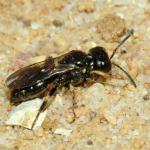A small, black wasp superficially resembling Lindenius species, but with pronounced hairy eyes.
Cornwall to Kent and north to Glamorgan, Warwickshire and South-east Yorkshire. Abroad, the species is found widely in the Palaearctic Region, from Spain to Japan, and north Africa (Tunisia and Egypt) (Lomholdt, 1975-76).
This species is not regarded as being scarce or threatened.
Mainly found in sandy areas, often where the soil has a gravel content.
Univoltine; late May to early September, most frequent in July.
Small, adult Chrysomelidae (Coleoptera), particularly of the genera Chaetocnema, Crepidodera and Longitarsus (Lomholdt, 1975-76).
Nesting takes place in sandy slopes, often gregariously. The nest usually branches into cells, the maximum being about ten. 16-26 prey items are used per cell and the larva consumes these before spinning a cocoon covered on the outer surface with sand grains (Lomholdt, 1975-76).
Umbellifers generally. Both sexes often abundant. Bitsch, et al. (1997) list a wide range of species visited by E. brevis in France.
No information available.
2001


